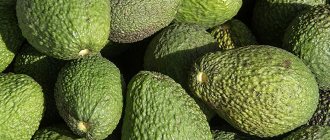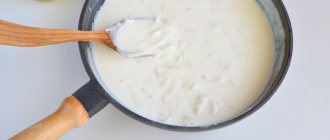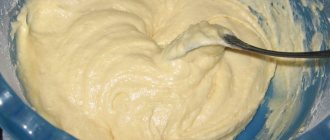In the refrigerator or at room temperature?
Every second person will ask himself this question when leaving the fruit department with a mango in his hands. But before you answer it, you must determine the degree of ripeness of the fruit. Here are the main signs of a ripe fruit:
- Characteristic sweet and rich aroma.
- When squeezed, elasticity should be felt, but not absolute hardness.
- The shape should be round and the skin should be smooth.
You shouldn’t rely on the color of the fruit; it can be anything: yellow, red, orange or green - it often depends on the variety. So, if your mango meets all the criteria described above, then it is ripe, ready to eat, and should be stored for no more than 3-5 days at low temperatures. It is best to put it in the refrigerator, without wrapping it in films or bags, so that the fetus can breathe.
To keep ripe pulp fresh for several months, use the freezer. The fruit is peeled, cut into medium-sized pieces and placed in the freezer. Taste qualities are not affected during the freezing process. The only thing is that the structure of the product may become somewhat softer and looser.
If in the supermarket you come across a fruit with a hard structure and without a characteristic smell, it means that it is not yet fully ripe. In this case, there is no need to be upset. Just keep unripe mangoes at room temperature to allow them to develop their sweetness.
Take the fruit, wrap it in newspaper or other paper and leave it on a sunny windowsill. In such conditions, the mango will ripen in 2-5 days. When, after the described manipulations, the fruit has become soft, juicy and aromatic, it can be consumed immediately or transferred to the refrigerator. At room temperature, ripe fruit will very quickly begin to undergo rotting processes.
How to store mangoes at home?
Not so long ago, mango was considered a very scarce exotic fruit that only came to the table of a select few. Now this product can be found on the shelves of almost every fruit store.
Despite its increasing popularity, many housewives still do not know how to properly store mangoes. Where and how long should you store the product so that it lasts longer? It all depends on several factors, and first of all on the degree of maturity of the product.
Choosing a fruit
Often inexperienced housewives believe that the maturity of a fruit can be determined by the color of its peel. This judgment has nothing to do with the real state of affairs. In fact, the color of the peel of the fruit depends only on its variety, and ripe specimens can be either yellow or green.
What then should you pay attention to when choosing a product?
- First, you need to smell the object. A fully mature specimen has a rich, sweet aroma. An unripe fruit does not have this aroma.
- Secondly, you need to lightly press on the fruit. A fruit that has not reached the peak of ripeness will be completely hard; such a specimen still needs to lie down. When pressed, a ripe product shows the elasticity of the pulp.
- Thirdly, when choosing a treat, its shape is also important. It is better to choose even, round fruits with smooth, intact skin.
Advice! Don't be afraid of unripe mangoes. You can place it at room temperature to ripen and enjoy the ripe fruit after 5-6 days.
When choosing a product based on the tips described above, you need to consider the purpose of the purchase. If you need to eat the fruit right away, then you should look for the most ripe options; if you need to buy the product for future use, it is better to choose fruits that are not fully ripe.
Storing exotic fruit
What is the best way to store mangoes from Thailand? For some reason, many people believe that this fruit cannot be stored in the refrigerator. And this opinion is again wrong. Where an exotic stock is stored determines its maturity.
A well-ripened fruit must be stored at low temperatures. Under no circumstances should ripe mangoes be stored in heat, and especially in the sun.
The fruit becomes soft and under the influence of a large amount of sugar inside it begins the fermentation process and the proliferation of bacteria that can cause human diseases.
Even in the refrigerator, it is better not to store a ripe specimen for more than 3 days. It is better to place mangoes in the compartment for vegetables and fruits. There is no need to pack the fruit in a bag or wrap it in film; you can wrap it in parchment. To ensure that the peel does not wrinkle over time and does not lose its presentable appearance, experienced housewives recommend wiping it with vegetable oil and drying it.
But the immature representative just does not tolerate the cold. In a cool room, the ripening process is slowed down. Therefore, it is better to place unripe specimens at room temperature to ripen, after which they can be stored in the refrigerator.
How to preserve for a long time?
How to store mangoes longer? Yellow fruits can be stored for a long period, but only if they are dried or frozen.
Freezing
To properly freeze a mango, you need to peel it and remove the pit. It is not recommended to freeze whole fruits. Storage of frozen pulp can last up to 6 months. At the same time, the exotic representative does not lose its taste and juiciness.
The only negative point may be that the pulp loses its structure. It becomes softer and looser. But despite this, frozen mangoes are very good for use in baking or making desserts.
Advice! In countries where mango is a common and native fruit, it is stored by soaking it in a saline solution. This makes its skin dense and crispy, and, accordingly, increases its shelf life.
Alternative storage methods
Mangoes can be successfully stored not only fresh, but also processed. Drying will help you get a shelf-stable product and an excellent snack. In order for the pulp to dry properly, it must first be blanched in sugar syrup. The degree of syrup concentration will depend on your taste preferences.
You can easily prepare dried fruits in the oven. Place slices 2-3 millimeters thick on a baking sheet lined with foil. The temperature must be set at 40°C. In this case, the oven door must be slightly open.
You can simply store the finished product in a cupboard or refrigerator. The main thing is to prevent excessive moisture.
Mango is a very delicate and demanding fruit, not suitable for long-term storage. Remember this and don’t buy it in advance, so that later you don’t have to wriggle out and save the softened fruit. And be sure to carefully inspect the mango before purchasing it. Give preference to absolutely whole and smooth fruits, because any scratches, bruises and stains can significantly reduce its shelf life.
Take the fruit, wrap it in newspaper or other paper and leave it on a sunny windowsill. In such conditions, the mango will ripen in 2-5 days. When, after the described manipulations, the fruit has become soft, juicy and aromatic, it can be consumed immediately or transferred to the refrigerator. At room temperature, ripe fruit will very quickly begin to undergo rotting processes.
How to help “ripen” mangoes at home?
If you buy a mango that is not quite ripe at the store, can it be ripened at home to become juicy and tasty?
put it in a dark place, just not in the refrigerator, but it will still not be juicy
Mango is an exotic fruit that does not grow in our latitudes. That’s why they bring it, but for transportation you need a hard fruit. unripe.
Unfortunately, mango is a very delicate product, although there are varieties with thick skin, but in order to deliver it safely, it is picked completely green.
It is already ripening on store shelves.
If you bought a hard mango, just let it sit in a vase in the kitchen for a few days, the fruit will ripen on its own.
But as soon as it becomes soft, immediately put it in the refrigerator or freeze it.
Therefore, you can safely buy firm mangoes and let them ripen at home.
Of course, such a mango will never taste like honey, as it does in its homeland.
If you bought a hard mango, just let it sit in a vase in the kitchen for a few days, the fruit will ripen on its own.
How to preserve unripe fruit until ripening
How to choose
If you come home from the store and find that you bought an unripe exotic fruit, do not rush to get upset. Mangoes can be easily ripened at home. For this:
- wrap the fruit in paper;
- put it in a dark place;
- If you have an apple on hand, you can place it in a bag with mango - a ripe apple releases ethylene, which will speed up its ripening.
At room temperature, the fruit will ripen in 3-5 days.
The smell of a ripe mango has a characteristic fruity aroma, while an unripe fruit does not have any odor. Alcoholic fermentation occurs in fruits that are overripe and begin to deteriorate.
The mango should be moderately soft to the touch, since a hard peel indicates that the fruit is unripe. The ripe fruit has a round, smooth surface with characteristic brown spots.
A hard and strong peel indicates that the fruit is unripe, while damage and cracks on the surface, on the contrary, indicate that the fruit is too ripe. Therefore, when choosing a ripe mango, you need to pay attention to these aspects.
We invite you to read Why wine turns into vinegar: how to identify and correct it, prevention, methods of application
How to store mangoes
It’s good that there is no shortage in stores and you can buy and try all sorts of exotic fruits, including mangoes. Every housewife should know how to store this tasty and very expensive fruit, because we don’t buy it every day.
Mangoes are brought to us from India and Thailand; by the way, the most delicious and juicy varieties grow in Thailand. The fruit picking season begins in January and lasts until mid-May, so mangoes reach our table in winter and are sold until summer. Fruits are picked at the beginning of ripeness, and then they are gradually delivered throughout the world.
How to store mangoes at home
First of all, you should be able to choose the most delicious and juicy fruit correctly. Full ripeness is indicated by a characteristic strong aroma and sweet taste. To choose the right mango, take those fruits that have a round shape and smooth skin, and when pressed, you feel elasticity, which indicates ripeness. But if you want to save the mango for later, you should choose a fruit that is slightly unripe - it has a hard texture and an inexpressible aroma.
Here's how to store mangoes at home:
- in a refrigerator;
- on the table in a fruit basket;
- in a dark, cool place (pantry or cellar);
- in the freezer;
- heat treated.
Interesting: Is it possible to make wine in stainless steel cookware?
If you bought ripe fruit, but will not use it yet, you should know how to store mangoes from Thailand and where.
Ripe fruit will retain its flavor best if placed on a plate and placed on the middle shelf in the refrigerator. At a temperature no higher than +5°C, you can store mangoes at home for up to 1 week, making sure that the fruit does not begin to turn black.
You can also wrap the mango in paper and take it to a dark, cool place, where, at a temperature no higher than +5°C and a relative humidity of 90-95%, it will be stored and, if necessary, ripened.
Storing cut mango
In order not to later wonder how to make a mango ripe, it is better to be able to determine the degree of ripeness of the fruit even when purchasing. It is not difficult:
- The ripe fruit exudes a bright, sweetish-resinous, fruity smell, especially in the area of the stalk.
- When pressed, the flesh springs slightly, like a ripe peach.
- The skin of the ripe fruit is shiny, smooth and dense, the color varies from yellow to red-orange depending on the variety. There are varieties of green mango with orange flesh, but they are extremely rare on our shelves.
- Dark spots on the surface of the fruit do not always indicate that the product has begun to deteriorate. The fruit probably contains a lot of sucrose. However, if the spots are soft and can be easily pressed with a fingernail, it is better not to buy the fruit.
- The most delicious and aromatic fruits have a spherical shape.
We suggest you read: How to properly peel a mango
The ripe fruit smells of both pineapple and peach with a light trail of pine needles. Connoisseurs of this exotic fruit are sure that the strong aroma indicates one hundred percent ripeness.
Storage rules:
- Do not put green fruits in the refrigerator - the ripening process in such conditions will slow down and the product will spoil. Keep ripe and overripe fruits in the crisper drawer in the refrigerator compartment.
- The shelf life of ripe fruit in the refrigerator is 5-6 days at a temperature of 2... 5°C, in the freezer - six months at –18°C. When frozen, the product retains its taste.
- Cut fruit quickly deteriorates, the flesh darkens and loses its taste. Store this product in a food container with an airtight lid for no more than 24 hours.
- Unripe mangoes can be stored for up to 7 weeks at a temperature of 7... 9°C and air humidity of 90%.
Cut mangoes cannot be preserved for a long time. When exposed to air, the pulp will begin to darken. But if you sprinkle it with lemon juice, you can briefly extend the storage period.
How to store unripe mangoes so they ripen
If you bought unripe fruit, you can bring it to ripeness. To do this, place the mango on a plate and keep it at room temperature in the kitchen for 3-5 days. You can also speed up the ripening process of mangoes by placing them in a bag with a ripe apple and placing them on a windowsill in direct sunlight. Ripe apples release ethylene, which will speed up the ripeness of the mango, and it will take only 1-2 days for the exotic fruit to become completely ripe.
Should mangoes be stored in the refrigerator? Green mangoes should not be stored in the refrigerator until they are ripe. Even if the fruit reaches maturity, it will not be sweet. Storage conditions at low temperatures in the pulp slow down the processes by which sugar is formed in the fruit, so the visually ripe fruit inside will be grassy and tasteless.
The main signs that a Thai mango is fully ripe:
- rich sweet aroma;
- smooth skin;
- yellow spots;
- elastic consistency.
Once you have brought an unripe green fruit to full ripeness, you cannot store it without refrigeration. At room temperature, a juicy exotic mango will quickly rot, and you need to either eat it or put it in the refrigerator on the middle shelf, where at a temperature no higher than +5°C, store green mangoes for no more than 1 week, making sure that the fruit does not turn black.
How to ripen a mango
So, mangoes are in the string bag, now the simplest thing remains - bring them to ripeness and you can eat them. But the question arises: where to put the fruit and how to find out whether it is ripe and how much is left. There are several tricks to make mangoes ripe:
1. Paper method
Unripe mangoes are wrapped in a sheet of parchment or other paper bag. There are many articles claiming that regular newspaper is also suitable for this, but it is better not to use it: printing inks contain a large amount of lead, and it is undesirable to allow it to come into contact with food. Place the resulting bag on a shelf and leave for about a day. There should be room for the fruit inside the package; it is better if the fruit rolls around there a little, natural gas - ethylene - will be freely released and this will prevent mold from forming. As the mangoes ripen, the room will be filled with an enchanting tropical aroma.
Expert opinion
Anna Petrova
The transformation of a “woody” mango into a juicy delicacy will be noticeably accelerated if an apple is added to the package.
2. Cereal method
Indians offer another trick to “grow” a purchased delicacy at home. The fruit is placed at the bottom of a deep bowl or container, and then covered with millet or any other cereal. Even dry corn kernels will do. All you have to do is wait about eight to ten hours - and you can treat yourself to the juicy amber pulp.
Each fruit ripens differently, so it is worth checking the condition of the fruit approximately every three to four hours to prevent it from over-ripening.
3. The natural way
You don’t have to bother with such tricks at all, but simply leave the mango lying at room temperature on a plate or tray. This way the fruit will ripen on its own.
other methods
You can often hear the opinion that mangoes will ripen in the refrigerator, and that storing them there is even better, since the cold will prevent the fruit from turning sour. This statement is only partly true. You won’t be able to speed up ripening this way, so it’s better not to use this method. The mango will remain in the refrigerator, but it will not become sweet, and the pulp will acquire an unpleasant texture and taste.
Storage in the freezer is allowed, but to do this, you should wrap the fruit in a layer of paper or cellophane so that it does not come into contact with other products. On the “cons”, mangoes can be preserved for up to six months.
How to store mangoes in the refrigerator
The manufacturers of modern models have taken care of where it is best to store mangoes from Thailand in the refrigerator, creating a “freshness zone”. This is a special separate shelf with constant air ventilation, which maintains the optimal temperature of +3°C for long-term storage of products. Here, storing mangoes will be optimal; the fruit should be wrapped loosely in paper and stored for no more than 10 days, making sure that it does not turn black or become too loose.
If there is no such special shelf in your refrigerator, the mango should be wrapped in paper or put in a paper bag and stored on the middle shelf, at a temperature of +3...+5°C, for 1 week.
How to store mangoes in the freezer
Freezing is a great way to preserve the flavor of a mango if you don't eat it all. Some housewives doubt whether this fruit can be frozen. We hasten to assure everyone that this method of storing mangoes at home is ideal for preserving its taste and aroma.
To do this, the ripe fruit should be peeled and cut into pieces, which you will then use in the recipe. Place mango pieces on a plate, wrap in a bag and freeze. Then remove the plate, tie the bag tightly or put the frozen mango in a special container for storage in the freezer with a tight-fitting lid. The storage temperature for mangoes in this form is -24...-18°C, and the length of time the fruit is stored is no more than 3 months. After defrosting, the exotic fruit completely restores its aroma and taste.
Other ways to store mangoes
There are several more ways to better preserve the taste and aroma of this exotic fruit:
- make confiture;
- make jam;
- soak in sugar syrup;
- soak in salt water;
- cut into pieces and dry;
- make marshmallow;
- Make mango marmalade.
All of these methods are great for storing mangoes; they are the same fruit as our usual apples, plums or raspberries. Therefore, the methods for storing mangoes at home will be identical.
You can cut the mango into slices and dry it in the sun in a warm, well-ventilated room (on the balcony in summer), covered with gauze. You can also use an oven or a special dryer for this purpose. Having brought the fruit to the state of elastic (not brittle!) pieces, they should be placed in a clean glass jar and the mango should be stored in this form for no more than 6 months in the refrigerator.
Soaked mango pieces for salads should be stored in brine or syrup in the refrigerator for no more than 7 days.
The finished mango marshmallow or marmalade should be stored in the refrigerator, on the bottom shelf, in a deep plate, layered with paper, for no more than 7 days.
Mango jam or confiture, sealed in jars, should be stored at room temperature for no more than 1 year.
See also:
Did you cook a lot of corn but didn't eat it all at once? No problem! We'll tell you all about how you can keep it just as tasty.
Juicy, ripe, tasty watermelon is a real delicacy. We invite you to find out how to properly store it at home.
There are many different varieties of melon in the world. And each one is stored differently. More details at the link.
Many people like to pick berries. Blueberries are very popular among foresters. We suggest you find out how to properly store it at home.
Have you picked a lot of wild strawberries? We invite you to read an interesting article that will tell you a lot of interesting things about how it should be stored.
Interesting: Can ready-made baby formula be stored in the refrigerator?
Candied fruits are a delicious sweet that came to us from the East. All the storage secrets are delicious in our article!
- rich sweet aroma;
- smooth skin;
- yellow spots;
- elastic consistency.
What to do if the fruit is unripe and how to store it
The homeland of mangoes is Eastern India. But over time, it began to be grown in other countries with a tropical climate. Basically, this exotic fruit comes to us from Thailand.
The fruit is not only tasty and aromatic. It contains vitamins A, C, D, group B. The composition includes minerals: calcium, zinc, potassium, iron, phosphorus, manganese.
The exotic fruit is an indispensable product for weight loss. It has practically no calories and protein, so you can’t keep a diet for a long time on mango alone. It must be combined with a product that contains protein, for example, milk. You can make a smoothie or simply drink the fruit with milk - it’s tasty, healthy and low in calories.
We invite you to read When to pickle cabbage in December 2020 according to the lunar calendar: favorable days, when and how best to pickle cabbage, recipes
How to choose
There are more than 300 types of mangoes. The color spectrum of the fruits is also diverse: there are green, red-green, red, light yellow and bright yellow with red splashes.
To choose a ripe fruit, do not pay attention to its color.
When choosing, focus on:
- the elasticity of the fruit - it should not be hard, but when pressed it should not leave dents;
- aroma - ripe fruits have a pleasant smell;
- pulp color – when cut, the pulp should have a bright yellow color.
The method and period of storage of the fruit depend on the stage of its ripeness.
Mango shelf life depending on temperature:
- at room temperature – no more than 5 days;
- in the refrigerator – 10 days;
- in the freezer – no more than 3 months.
If you purchased unripe fruit, it can be brought to the desired condition at room temperature. And if the fruit is ripe, it cannot be stored at room temperature. But you can make jam or preserve it in syrup, dry it or make pastille. The same methods of preservation are suitable as for our usual fruits - apples, peaches.
In a refrigerator
This storage method is suitable for ripe fruits.
The most suitable place for mangifera fruits in the refrigerator is the lower shelves or drawers. If the refrigerator is equipped with a “fresh zone”, then store the fruit in it. Wrap each fruit separately in paper or place in a paper bag.
The shelf life of fruit in the “fresh zone” is no more than 10 days, on regular shelves – no more than 7 days.
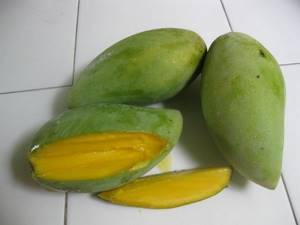
Many housewives like to freeze fruits for the winter. However, this is not the best method for mangoes. When frozen, vitamins and fatty acids are destroyed, so there will be virtually no benefit left from the fruit after defrosting.
If you decide to freeze this fruit and keep it longer:
- peel the fruit and cut into cubes;
- place the slices on a plate and cover with film or a bag;
- put in the freezer and let the pieces of fruit freeze - this will prevent the cubes from sticking together into one big lump;
- take it out, place it in a bag, tie it tightly and put it back in the freezer.
We invite you to familiarize yourself with Midge bite - photos, symptoms and treatment, how long the bites last
After defrosting, the taste remains virtually unchanged, and the pulp does not turn into a sticky mass.
If the mango is unripe, the fruit can ripen indoors (you need to wrap the fruit in a paper bag and leave it for several days). During storage, ethylene gas is produced, which can cause mold and mildew on the peel, so it is necessary to provide air supply to the storage container.
For faster ripening, mangoes are placed next to other fruits (apple, banana), and in other countries the fruits are placed in a pan with rice or corn.
It is not recommended to store the fruit in the refrigerator, as it can quickly spoil at low temperatures. In this case, ripe mango has a shelf life of up to 5 days, and the pieces are placed in a sealed container. Frozen product can be stored for 6 months.
How to store mangoes at home
Exotic fruits have long ceased to be in short supply, and you can buy them all year round in any supermarket. The question of how to store mangoes becomes relevant in winter, when the tropical fruit is delivered to our country from India and Thailand.
The fruit grows on a tree called mangifera, an ancient evergreen plant, especially common in countries with hot climates. The harvest is harvested at the beginning of ripeness, and it does not always have time to ripen before it hits the shelves of our stores.
We will tell you about the rules for storing mangoes at home (so that the fruit ripens and does not spoil) in this article.
Mango Egypt: what kind of fruit?
Last year we started importing mangoes from Egypt and received a lot of positive feedback. Therefore, we decided to ask technologist Sergei Kim more about it.
The result is a whole story about the mango's journey.
What is special about Egyptian mangoes?
From Egypt we only bring the Kate variety. It is also grown in other countries, but, according to Sergei, Egyptian is the sweetest. It does not have specific aromas and fibers that get stuck between the teeth.
The downside of this mango is its short season. It lasts from mid-August to mid-December. The Egyptians' cultivation technology is not yet as developed as that of the Peruvians or Thais, so it is not possible to preserve the fruit for a long time.
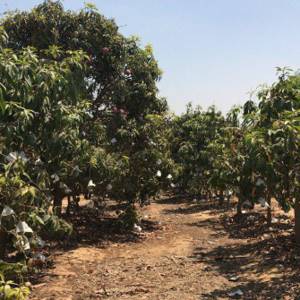
In Egypt, mangoes are not processed in any way - they are simply packed into boxes and sent to Russia. From the moment the fruit is cut from the tree until it is completely spoiled, only about a month passes. In August, the harvest begins in the southern regions of Egypt, and in the fall the turn comes to the north.
How mangoes get to us
From the packing station, mangoes are loaded into containers with an internal temperature of about 10-15 °C and transported to the port of Alexandria. From there it is loaded onto a ship and sails for a week to Novorossiysk. There are still 1-2 days of travel to Moscow. But this is not the end.
The mango arrives in the capital at the ripening station, where it takes 3-5 days to reach its best condition. At the distribution center it is tested in a laboratory. And only after that the fruit gets into stores. There, sellers selectively try new products. If there's something wrong with a mango, it doesn't make it onto the shelves.

Why are ripening chambers needed?
Buyers ask us whether ripening chambers affect the usefulness of the product. There is nothing dangerous in this procedure. It’s just that at the beginning of the season, mangoes are collected while still unripe and before sale they are exposed to ethylene, a natural gas that activates the ripening processes.
By the middle of the season, natural processes begin in the fruit and ethylene is no longer needed. At this stage, the technologist only helps the mango to ripen a little, storing it in a room with a temperature of 20-25 degrees.

Our specialist makes a sample, examines the appearance of the fruit and measures the level of sugar and solids. Based on this, he decides at what temperature, how and how many days to ripen the mango. In essence, the technologist helps the fruit do what it can do in nature, but at the moment we need.
Can you grow mangoes at home from seeds?
At home, it is almost impossible to ripen mangoes. After all, why does it grow in southern countries? The plant does not tolerate frost - during the growing season, mango must maintain a temperature of 30-40 degrees. Even if you manage to grow a bush from a seed, you still need to graft it onto a tree to get fruit. Although, with special equipment and patience, anything is possible.
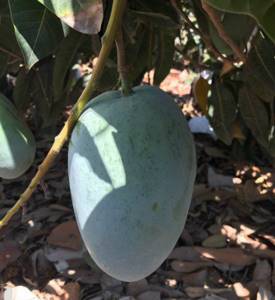
Why is the delivery process so complicated?
Previously, mangoes were sent only by plane. This turned out to be expensive, and as a result, the cost of the fruit did not please buyers. We adopted the experience of selling ripened mangoes from Europeans - it turned out that the costs of supplying them are lower, and the quality is not lost.
Of course, with such a multi-stage process, there are difficulties: sometimes ships are delayed due to bad weather, sometimes a container breaks along the way. Once the suppliers completely mixed up the varieties. We think not on purpose - you can’t tell them apart by sight. The substitution was eventually discovered by sellers when most of the mangoes tasted sour. I had to write off the entire delivery. 2 tons lost.
Due to the lack of any processing, Egyptian mangoes are also susceptible to anthracnose. These are black spots that form on the peel towards the end of the season. They appear due to the characteristics of the soil and climate in a hot country. The inside of the fruit is absolutely normal and you can eat it calmly, but sometimes people get scared. Then the hotline employees or VkusVill salespeople explain what’s going on.
What kind of mango should you not eat?
The only time it is unsafe to eat a mango is if it tastes fermented. This means that the fruit is overripe and is no longer worth eating. Outwardly, it is difficult to understand, because the fruit begins to ripen from the bone, but is still dense to the peel. A very obvious option is if the mango is soft and crumbly to the touch. But our sellers immediately remove such copies from the shelves. In other cases, there is no danger hidden in mangoes - solid vitamins and a charge of good mood.
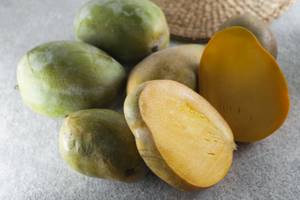
By the way…
Do you know how to easily and easily cut mangoes without getting your hands dirty? Watch our video and repeat:
Where to store mangoes at home
First of all, you should choose the right overseas fruit. Full ripeness is indicated by the characteristic aroma, juiciness and sweet taste. Give preference to round-shaped fruits with even, smooth skin that feels elastic when pressed.
Specimens with delicate pulp are suitable for eating and preparing preparations. If you want to keep mangoes fresh for longer, you need to choose a slightly unripe specimen. Such fruits have a dense structure and an unexpressed aroma.
Depending on the condition of the fruit, it can be stored in the following places:
- In the refrigerator, cellar or pantry.
- In the freezer.
- At room temperature.
Ripe fruits are best placed in a paper bag and placed on the middle shelf of the refrigerator. How long will this fruit last? If the temperature is maintained at +3...5 ℃, mango will remain fresh for up to 7 days.
Modern units have a separate niche with increased air ventilation, designed for long-term storage of fruit. If you have this particular model of refrigerator, then wrap the mango in parchment and place it in this area. In such conditions it will last up to 10 days.
Remember to inspect your inventory regularly to spot signs of spoilage. Using the same principle, fruits are stored in a cellar or pantry, where they are usually placed on a rack or in a box.
Overripe fruits will quickly turn black even in the refrigerator, so they should not be stored.
If you bought an unripe fruit, you can bring it to ripeness at home. Mangoes need to be stored at room temperature for 3-5 days to ripen. To speed up the ripening process, place it in a paper bag along with one apple or banana and place it in direct sunlight, such as on a windowsill.
You cannot store unripe fruit in the refrigerator, where even if it ripens, it will lose its sweetness and pleasant taste . If the green fruit is ripened at home, then after full ripeness it must either be eaten immediately or sent to a cold place: ripe pulp will quickly deteriorate at room temperature.
Freezing is a great way to preserve mangoes if, for example, you don't eat the whole fruit in one go. In the freezer it will retain its original qualities and after thawing it will not differ from fresh fruits.
To implement the method, peel the fruit and cut into small pieces. Place the workpiece on any flat surface, for example, a plate or tray, and place it in the freezer for several hours. When the pieces have hardened well, place them in a bag or airtight container. At a temperature of −18 ℃ and below, the fruit can be stored for no more than 3 months.
How to “ripen” a hard mango?
In countries where mangoes are often sold unripe, they have come up with many good ways to bring this fruit to the desired condition at home.

Method one - bag + apples
Apples have a special property - they emit ethylene. This gas promotes the rapid ripening of fruits, so to quickly make a mango soft and sweet, just put it in a paper or plastic bag with apples and tie it loosely. The riper the apples, the more active the process.
If apples are not available, they can be replaced with ripe and even overripe (but not rotten) bananas.
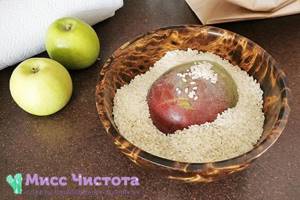
Method two - pan + rice
Eastern and Asian countries have their own way of making mangoes ripen in a matter of days (or even hours). The local residents use rice for this - they pour it into a deep pan or other container, and then “bury” the hard and undamaged fruits there. It is advisable to ripen one fruit in one container, but if the pan is large in diameter, 2-3 mangoes can fit in it at once. In this case, they should not lie close to each other, but be separated by a layer of rice several centimeters thick.
If you decide to ripen the fruits in rice, check them every 6-12 hours. Otherwise, there is a risk that the mangoes will be overripe.
Method three - time + patience
This is the longest option. You just need to put the fruit in a vase and leave it on the table. Under the influence of sunlight, ripening processes will begin in it. How long it takes for an unripe mango purchased to acquire softness and heavenly taste depends on the variety and degree of ripeness. On average it is 5–10 days.
We recommend: Boost your immunity: healthy potions and desserts made from viburnum
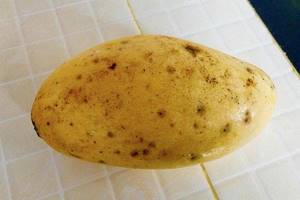
Other storage methods
There are other methods to preserve the aroma and taste of an exotic fruit. From it you can prepare:
Like other types of fruits, mangoes are dried . To do this, cut it into thin slices and place it in a warm, ventilated room, covered with gauze. To speed up the process, use a dryer or oven. The dried pieces should be elastic, but not brittle. Place the preparation in a dry glass jar, which you store in the refrigerator.
Many people soak mangoes in brine or syrup, depending on the method of further use. In these liquids it is stored in a cold place and added to salads or desserts as needed.
The table shows the shelf life of various types of preparations:
| Type of workpiece | Storage conditions | Best before date |
| Jam, confiture | In a cold place or at room temperature | Up to 1 year |
| In the refrigerator on the bottom shelf in a deep container | Up to 7 days | |
| Soaking | In a refrigerator | Up to 7 days |
| Drying | In a refrigerator | Up to 6 months |
If you are wondering how to store mangoes at home, remember that they are the same fruit as an apple or a pear, so the storage methods are often identical. Use our tips to enjoy the exotic taste and aroma of the fruit for a long time.
We invite you to watch a video about how to choose the right tropical fruit in the store:
A young housewife, she is immersed in raising children and running a household. Like a mother, she can quickly figure out what to do with her child, like a wife, she can cook a delicious three-course meal, like a housewife, she can create coziness and comfort in the house. I’m glad to share with readers life hacks that can make household work easier and save time for your favorite work and travel.
Found a mistake? Select the text with the mouse and click:
The dishwasher cleans more than just plates and cups. You can load it with plastic toys, glass lamp shades and even dirty vegetables, such as potatoes, but only without using detergents.
Stretch ceilings made of PVC film can withstand from 70 to 120 liters of water per 1 m2 of their area (depending on the size of the ceiling, the degree of its tension and the quality of the film). So you don’t have to worry about leaks from neighbors above.
Threads made of gold and silver, which were used to embroider clothes in the old days, are called gimp. To obtain them, the metal wire was pulled for a long time with pliers to the required fineness. This is where the expression “to drag out the rigmarole” came from - “to do long, monotonous work” or “to delay the completion of a task.”
The habit of using an automatic washing machine “sparingly” can lead to the appearance of an unpleasant odor in it. Washing at temperatures below 60℃ and short rinses allow fungi and bacteria from dirty clothes to remain on internal surfaces and actively multiply.
Before removing various stains from clothing, you need to find out how safe the selected solvent is for the fabric itself. It is applied in a small amount to an inconspicuous area of the item from the inside out for 5-10 minutes. If the material retains its structure and color, you can move on to stains.
There are special traps to combat moths. The sticky layer with which they are covered contains female pheromones that attract males. By sticking to the trap, they are eliminated from the reproduction process, which leads to a decrease in the moth population.
The easiest way to remove scale and carbon deposits from the soleplate of the iron is with table salt. Pour a thick layer of salt onto the paper, heat the iron to maximum and run the iron over the salt bed several times, applying light pressure.
Fresh lemon is not only suitable for tea: clean dirt from the surface of an acrylic bath by rubbing with half a cut citrus, or quickly wash the microwave by placing a container of water and lemon slices in it for 8-10 minutes at maximum power. The softened dirt can simply be wiped off with a sponge.
If your favorite things show the first signs of gestation in the form of untidy pellets, you can get rid of them using a special machine - a shaver. It quickly and effectively shaves off clumps of fabric fibers and returns things to their proper appearance.
Many people soak mangoes in brine or syrup, depending on the method of further use. In these liquids it is stored in a cold place and added to salads or desserts as needed.
How to Ripen Mangoes at Home
To start the meal, the fruit must be peeled. First, wash the fruits thoroughly - remember that they have made a long and long journey to your table, so a lot of dirt and bacteria have accumulated on their peel. Afterwards, wipe the fruit with a towel. It is very convenient to peel a medium-sized oblong mango (these are the ones most often sold in Russia) by placing it vertically on a plate. That's right, because the fruit itself is very juicy, and if you start peeling it without a stand, there is a high risk of staining the surface of the table with sticky juice. Next, cut off the peel from all sides with a knife, holding the fruit by the top - you're done. Now the mango pieces can be cut into cubes (see photo above) or slices and served. But still, how do you eat mango fruit? Actually, the fruit is good on its own - without any additives. Ripe and sweet, it will be an excellent dessert for adults and children. Ideally, the pieces are served on a dessert plate and eaten with a fork. If the mango is cut into slices, then it must also be served with a knife. True, not many houses observe these subtleties of etiquette; nevertheless, we are more accustomed to eating fruits with the help of cutlery in a restaurant or at a party. Also be careful because mangoes have a very sweet and sticky yellow juice. If you eat it carelessly, there is a risk of staining your clothes, hands and face. Another way to eat mango: the fruit as is – peeled, but without any additives – can be ground in a blender and made into a natural puree for ice cream or biscuits. But in Asia, mangoes are eaten not only for sweets - below are examples of what else this fruit can be served with.
To start the meal, the fruit must be peeled. First, wash the fruits thoroughly - remember that they have made a long and long journey to your table, so a lot of dirt and bacteria have accumulated on their peel. Afterwards, wipe the fruit with a towel. It is very convenient to peel a medium-sized oblong mango (these are the ones most often sold in Russia) by placing it vertically on a plate. That's right, because the fruit itself is very juicy, and if you start peeling it without a stand, there is a high risk of staining the surface of the table with sticky juice. Next, cut off the peel from all sides with a knife, holding the fruit by the top - you're done. Now the mango pieces can be cut into cubes (see photo above) or slices and served. But still, how do you eat mango fruit? Actually, the fruit is good on its own - without any additives. Ripe and sweet, it will be an excellent dessert for adults and children. Ideally, the pieces are served on a dessert plate and eaten with a fork. If the mango is cut into slices, then it must also be served with a knife. True, not many houses observe these subtleties of etiquette; nevertheless, we are more accustomed to eating fruits with the help of cutlery in a restaurant or at a party. Also be careful because mangoes have a very sweet and sticky yellow juice. If you eat it carelessly, there is a risk of staining your clothes, hands and face. Another way to eat mango: the fruit as is – peeled, but without any additives – can be ground in a blender and made into a natural puree for ice cream or biscuits. But in Asia, mangoes are eaten not only for sweets - below are examples of what else this fruit can be served with.
08 Jul 2020 edypravilno 363
Share this post
- Related Posts
- How long can sausages be stored in the freezer?
- How to properly store potatoes in the cellar
- How long does sea water last in a bottle?
- How Long After Marinating Can You Eat Mushrooms?
